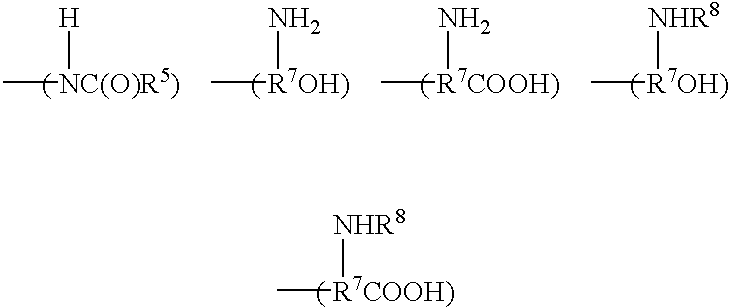Inhibition of exoprotein production in non-absorbent articles uisng aromatic compositions
- Summary
- Abstract
- Description
- Claims
- Application Information
AI Technical Summary
Benefits of technology
Problems solved by technology
Method used
Image
Examples
example 1
[0073]In this Example, the effect of various test compounds on the growth of S. aureus and the production of TSST-1 was determined. The test compound, in the desired concentration (expressed in percent of active compound) was placed in 10 mL of a growth medium in a sterile, 50 mL conical polypropylene tube (Sarstedt, Inc. Newton, N.C.).
[0074]The growth medium was prepared by dissolving 37 grams of brain heart infusion broth (BHI) (Difco Laboratories, Cockeysville, Md.) in 880 mL of distilled water and sterilizing the broth according to the manufacturer's instructions. The BHI was supplemented with fetal bovine serum (FBS) (100 mL) (Sigma Chemical Company, St. Louis, Mo.). Hexahydrate of magnesium chloride (0.021 M, 10 mL) (Sigma Chemical Company, St. Louis, Mo.) was added to the BHI-FBS mixture. Finally, L-glutamine (0.027 M, 10 mL) (Sigma Chemical Company, St. Louis, Mo.) was added to the mixture.
[0075]Compounds to be tested included phenylethyl alcohol, benzyl alcohol, and 2-hydro...
example 2
[0083]In this Example, the effect of various test compounds on the growth of S. aureus and the production of TSST-1 was determined. The effect of the test compounds tested in Example 2 was determined by placing the desired concentration, expressed in percent of the active compound, in 10 mL of a growth medium as described in Example 1. The test compounds were then tested and evaluated as in Example 1.
[0084]In accordance with the present invention, Table 2 shows that S. aureus (MN8), when compared to the control, produced significantly less TSST-1 in the presence of the aromatic compounds. The aromatic compounds reduced the amount of exotoxin production ranging from about 82% to 97%. However, although the amount of toxin produced was significantly reduced, there was minimal, if any, effect on the growth of S. aureus cells.
[0085]
TABLE 2% TestELISA:ReductionCom-OpticalTSST-1ofCompoundpoundDensityCFU / mLng / OD unitToxin (%)GrowthZero0.607>1.6E+09 2424N / AMediumMethanol400 μL0.5982.6E+0926...
example 3
[0086]In this Example, the effect of various test compounds on the growth of S. aureus and the production of TSST-1 was determined. The effect of the test compounds tested in Example 3 was determined by placing the desired concentration, expressed in percent of the active compound, in 10 mL of a growth medium as described in Example 1. The test compounds were then tested and evaluated as in Example 1.
[0087]In accordance with the present invention, Table 3 shows that S. aureus (MN8), when compared to the control, produced significantly less TSST-1 in the presence of the aromatic compounds. The aromatic compounds reduced the amount of exotoxin production ranging from about 69% to 98%. However, although the amount of toxin produced was significantly reduced, there was minimal, if any, effect on the growth of S. aureus cells.
[0088]
TABLE 3% TestELISA:ReductionCom-OpticalTSST-1ofCompoundpoundDensityCFU / mLng / OD unitToxin (%)GrowthZero0.6273.9E+091931N / AMediumMethanol100 μL0.5885.2E+092041N...
PUM
| Property | Measurement | Unit |
|---|---|---|
| Fraction | aaaaa | aaaaa |
| Fraction | aaaaa | aaaaa |
| Fraction | aaaaa | aaaaa |
Abstract
Description
Claims
Application Information
 Login to View More
Login to View More - R&D
- Intellectual Property
- Life Sciences
- Materials
- Tech Scout
- Unparalleled Data Quality
- Higher Quality Content
- 60% Fewer Hallucinations
Browse by: Latest US Patents, China's latest patents, Technical Efficacy Thesaurus, Application Domain, Technology Topic, Popular Technical Reports.
© 2025 PatSnap. All rights reserved.Legal|Privacy policy|Modern Slavery Act Transparency Statement|Sitemap|About US| Contact US: help@patsnap.com



